When he died in Paris, his last words were “god will forgive me. Its his job.” Among the thousands of books burned in Berlin in 1933 following the Nazi raid on the Institut für Sexualwissenschaft, were works by Heinrich Heine. To commemorate the terrible event, one of the most famous lines of Heine’s 1821 play Almansor was engraved in the ground at the site: “Dort, wo man Bücher verbrennt, verbrennt man am Ende auch Menschen.” :“Where they burn books, they will ultimately also burn people.” In the original text, Heine had been referring to the burning of the Quran during the Spanish Inquisition….
Even allowing for a conventional amount of flattery, the men and women that Heinrich Heine found on his arrival in Paris in May, 1831, were exceptionally elegant, beautiful, sensuous, intelligent and touched by the fire of romantic imagination. A generation was coming of age. Conceived between two battles, raised to the sound of Napoleonic drum, they now stood poised on the threshold of a new era, and Heine was caught up in this heady air of the dreamer; the utopian socialism of Saint-Simon who extolled an egalitarian paradise based on merit.
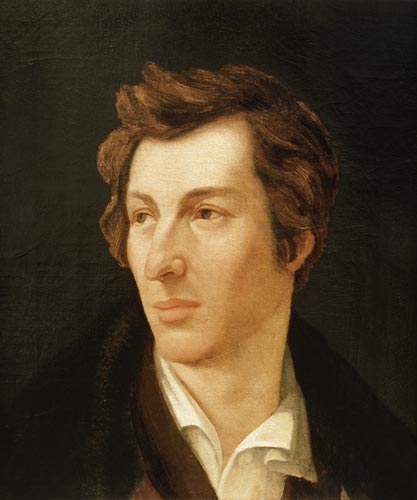
---Heine not only felt in himself the growing inner cleavage and the suffering of the artist in bourgeois society – he also analysed it. “Oh! Dear reader, when you feel like deploring this sense of being torn, you should instead deplore the fact that the world itself has been torn asunder at its heart. Since the heart of the poet is the central point of the world, in present times it must necessarily be woefully torn. Those who are able to boast that their hearts have remained whole are only admitting that they have a prosaic, narrow heart.”---Read More:http://en.internationalism.org/icconline/2007/march/heine image:http://en.internationalism.org/icconline/2007/march/heine
Heine plunged into this “maelstrom of events, the waves of the day, the seething revolution.” Paris for him was “a pantheon of the living.” All the important artists were here: “Paris is not merely the capital of France but of the whole civilized world, the mecca of the intellectual elite… A new art, a new life is being created here, and the creators of this new world lead tumultuously joyous lives.” He saw the romantic movement as a constellation of stars of the first magnitude, illuminating the whole of France with the fierce light of its ideas and ideals.”As the stars are the glory of the sky, so great men are the glory of their country, yea, of the whole earth. The hearts of great men are the stars of earth; and doubtless when one looks down from above upon our planet, these hearts are seen to send forth, a silvery light just like the stars of heaven. From such an exalted vantage point, one might perhaps perceive how many radiant stars are scattered over the face of the earth…. How radiant with them is France, the Milky Way of great human hearts!”
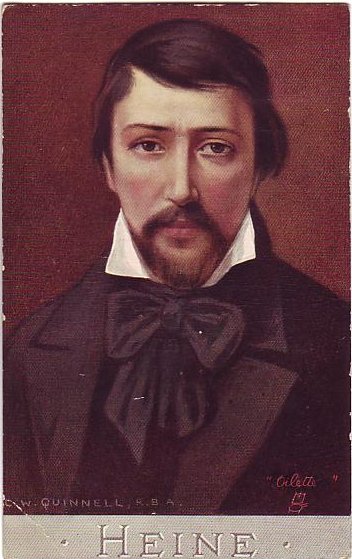
---.....was followed by an even more astounding prophecy: “If one day Satan… should be victorious, there will fall on the heads of the poor Jews a tempest of persecution which will far surpass all their previous sufferings…I shudder at the thought and an infinite pity ripples through my heart.” Heine, alone in his generation, was thus the first to foresee the Holocaust. That being said, nowhere in his ominous caveats did he ever accuse the Germans of collective guilt. He saw the nation as divided in two, and praised the “better and more beautiful half of the German people, but that is precisely the half that does not bear arms.”...Read More:http://www.culturaljudaism.org/pdf/Contemplate_Lossin.pdf image:http://www.listal.com/author/heinrich-heine/pictures
Heine was one of the first to bring the psychological truths of the unconscious to the surface. In doing so, he based himself on the wisdom of old tales. He thus opened up a path in the exploration of the human psyche, one which was to be taken up and further developed by the great realistic novelists like George Eliot in England, Dostoyevski and Tolstoy in Russia, but also by the “decadent” Kafka. And Freud recognised in Heine one of those who prepared the way for psychoanalysis. In this sense Heine was not only the poet of romanticism; he at the same time overcame it, through ironising the romantic pose. Read More:http://en.internationalism.org/icconline/2007/march/heine
Equally The horse-drawn omnibus had been introduced to Paris in 1828, and Heine regarded this as the perfect way to see the sprawling city. He took aimless rides around the oldest and most disreputable districts, and went slumming with the composer Giacomo Meyerbeer- disguised in workingmen’s caps and old jackets- in the dives and cabarets that surrounded Les Halles of the pre-cast-iron epoch. Nearby, in the galleries of the Louvre, Heine would wander for hours through endless collections of old masters, and the vast array of new paintings exhibited there each year at the official Salon. Afterward he remembered that what surprised him most about Paris in 1831 were the pictures he saw in that year’s exhibition, notably the great tribute to the July revolution, Liberty leading the People, that Delacroix had painted in a sudden access of patriotic fever and that had made its debut the very month of Heine’s arrival.
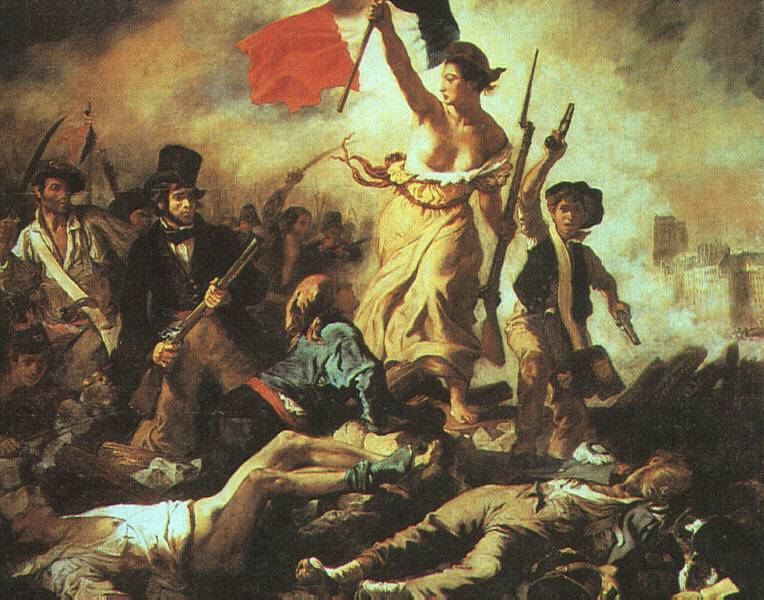
Delacroix. Liberty Leading the People. ---The flat empiricist was for Heine, the absolute antithesis of creative freedom. In the city of Göttingen, this kind of sour-faced Philistine appeared in academic cloth: ``The city of Göttingen, famous for its sausage and its university,'' he begins his Harzreise. In the Baths of Lucca, Heine again picks up the equation, and takes it further: ``Whatever the case, you can tell the universities of Göttingen and Bologna apart by the simple fact, that in Bologna you find the smallest dogs and the greatest scholars; in Göttingen the contrary, the smallest scholars and the largest dogs.'' And alluding to the feudalistic laws governing Germany: ``The Hanoverian Junker are donkeys, who only talk about horses;'' in another turn of phrase, Heine remarks that--: ``In general, the inhabitants of Göttingen are very strictly divided into four classes: students, professors, Philistines and cattle. The class of cattle is the most significant.'' --- Read More:http://american_almanac.tripod.com/heine.htm image:http://history.hanover.edu/courses/art/delalib.html
Heine’s essays on French politics all point to the fact that the work of the French Revolution in bestowing egalite on its citizens had been left unfinished. Despite the reassuring prescence of the felt hat and furled umbrella of Louis Philippe, the citizen-king and, as Heine said “the most bourgeois man in France,” there was widespread misery among the poor. France then had a population of about 32 million. As Armand Marrast wrote, among them were ” 500,000 sybarites, 1 million happy slaves, but 21 million helots and pariahs, condemned from birth to suffer all the possible tortures of mind and body.”
Though the old landed noblesse had lost its power, the country was now in the hands of the bankers, like Heine’s patron the Rothschilds. The government, according to the anarchist Proudhon, had become a veritible bancocratie. Heine agreed that power now resided in the decisions and transactions within the Paris Bourse, a great neoclassic temple of finance that had been one of Napoleon’s main architectural legacies. “The most beautiful building in Paris,” he said, adding that he was appalled with what went on inside, on the fl
of the exchange, ” with its shrill people and its grating sounds, the roar of voices like an ocean of self-interest, with the great bankers surfacing in this human sea like snapping sharks- this is where the interests reside that decide whetehr there shall be was or peace in our day” ( Grunfeld )
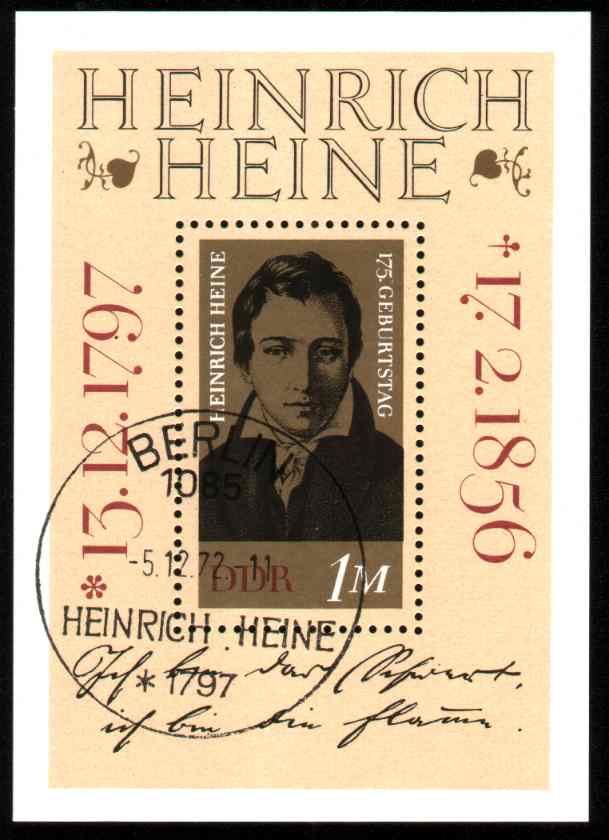
Heine identified the hatred of the body of Christianity as the source of this cleavage. “Whereas the Jews only treated the body with disdain, the Christians went much further down this path, considering it to be something to be rejected, as something evil, as evil itself.” Read More:http://en.internationalism.org/icconline/2007/march/heine image:http://rosettasister.wordpress.com/2010/06/
ADDENDUM:
Read More:http://www.giga-usa.com/quotes/authors/heinrich_heine_a001.htm
While Heine may not have been a philosopher with a systematic theory, his ideas fertilized different and even opposing strains of 19th century thought. Graetz compared him to a sovereign flinging handfuls of gold coins out the window of his carriage as he rode by. His ideas were borrowed not only by Marx, but by his polar opposite Nietzsche as well. Marx’s famous slogan “religion is the opium of the masses” (1844) was taken, without citing its source, from Ludwig Boerne: A Memorial (1840), and the Nietzschean thesis that “God is dead” (The Gay Science, 1882)comes from another book by Heine, Religion and Philosophy in Germany (1835). The works of yet another fan, Sigmund Freud, are similarly studded with quotations from Heine. Read More:http://www.culturaljudaism.org/pdf/Contemplate_Lossin.pdf
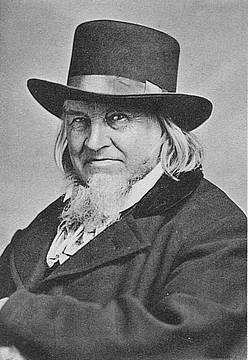
---...“Hoffmann von F”, who is mentioned in it, is Hoffmann von Fallersleben, who was dismissed from his Breslau professorship in 1842 for his ironically titled Unpolitical Songs. Hoffmann became a kind of 19thcentury beatnik poet, travelling about from inn to inn with his guitar and his popular songs, which Heine disliked intensely, regarding them as symptomatic of the beginning of the end of high art – one of the prices the world would have to pay for the rise of democracy....Read More:http://rosettasister.wordpress.com/2010/06/ image:http://www.uni-paderborn.de/mitteilung/10532/








 COMMENTS
COMMENTS



